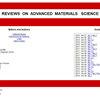用丁香酚改性甲基丙烯酸酯骨水泥--一种具有抗菌性能的新材料
IF 3.6
4区 材料科学
Q2 MATERIALS SCIENCE, MULTIDISCIPLINARY
引用次数: 0
摘要
如今,寻找非常规抗菌剂的工作非常普遍。其中一种可能是丁香酚(EU)(4-烯丙基-2-甲氧基苯酚),它对病原菌具有抗菌特性,并被用于制药业。由于其结构,丁香酚可降低聚合放热,但不会对转化率产生负面影响。我们将对 EU 改性骨水泥的特性(如成团时间、最高温度和凝结时间)以及机械特性、EU 释放和抗菌特性进行表征。骨水泥的合成方法是将两种市售甲基丙烯酸酯共聚物(Evonic)组成的粉相与含有甲基丙烯酸 2-羟乙基酯、甲基丙烯酸甲酯、三乙二醇二甲基丙烯酸酯和 EU 的液相混合在一起,混合量为骨水泥样品的 0.5 wt%。作为引发体系,使用了过氧化苯甲酰和 N,N-二甲基苯胺。用不同量的引发体系制备样品。骨水泥的成团时间、最高温度(T max)、凝结温度(T set)、凝结时间(t set)和抗压强度测试均按照 ISO 5833:2002 标准要求进行测定。骨水泥的成团时间取决于引发体系的数量。骨水泥固化过程中的最高温度非常低,但凝结时间更接近标准规定的上限。测试材料的抗压强度很好,大大超过了标准要求。此外,抗菌研究表明,测试的骨水泥对金黄色葡萄球菌或卷曲杆菌菌株具有抑菌作用。总之,改性骨水泥的所有参数都符合 ISO 5833:2002 标准的要求,并具有良好的机械性能(类似于或高于商用骨水泥)、高欧盟释放率和抑菌性能。本文章由计算机程序翻译,如有差异,请以英文原文为准。
Modification of methacrylate bone cement with eugenol – A new material with antibacterial properties
Nowadays, the search for unconventional antibacterial agents is very common. One of them may be eugenol (EU) (4-allyl-2-methoxyphenol), which exhibits antimicrobial properties against pathogenic bacteria and is used in the pharmaceutical industry. Owing to its structure, EU decreases the exotherm of polymerization without a negative impact on the degree of conversion. The properties of EU-modified bone cement, such as doughing time, maximum temperature, and setting time, will be characterized, as well as mechanical properties, EU release, and antibacterial properties. Bone cements were synthesized by mixing a powder phase composed of two commercially available methacrylate copolymers (Evonic) and a liquid phase containing 2-hydroxyethyl methacrylate, methyl methacrylate, triethylene glycol dimethacrylate, and EU with an amount of 0.5 wt% of bone cement sample. As an initiating system, benzoyl peroxide and N ,N -dimethylaniline were used. Samples were prepared with various amounts of the initiating system. The doughing time, maximum temperature (T max ), setting temperature (T set ), setting time (t set ), and compressive strength tests were determined according to the ISO 5833:2002 standard requirements. The doughing time for bone cement depends on the amount of the initiating system. The maximum temperature during curing of bone cement is very low; however, the setting time is closer to the upper limit set by the standard. The compressive strength of the tested materials is good and significantly exceeds the requirements of the standard. EU release was very high and ranged from around 43–62% after 168 h. Moreover, antibacterial studies show that the tested bone cements are bacteriostatic for Staphylococcus aureus or and Escherichia coil strains. In summary, modified bone cements meet the ISO 5833:2002 standard requirements in all parameters and are characterized by good mechanical properties (similar to or higher than commercial bone cement), high EU release, and bacteriostatic properties.
求助全文
通过发布文献求助,成功后即可免费获取论文全文。
去求助
来源期刊

Reviews on Advanced Materials Science
工程技术-材料科学:综合
CiteScore
5.10
自引率
11.10%
发文量
43
审稿时长
3.5 months
期刊介绍:
Reviews on Advanced Materials Science is a fully peer-reviewed, open access, electronic journal that publishes significant, original and relevant works in the area of theoretical and experimental studies of advanced materials. The journal provides the readers with free, instant, and permanent access to all content worldwide; and the authors with extensive promotion of published articles, long-time preservation, language-correction services, no space constraints and immediate publication.
Reviews on Advanced Materials Science is listed inter alia by Clarivate Analytics (formerly Thomson Reuters) - Current Contents/Physical, Chemical, and Earth Sciences (CC/PC&ES), JCR and SCIE. Our standard policy requires each paper to be reviewed by at least two Referees and the peer-review process is single-blind.
 求助内容:
求助内容: 应助结果提醒方式:
应助结果提醒方式:


